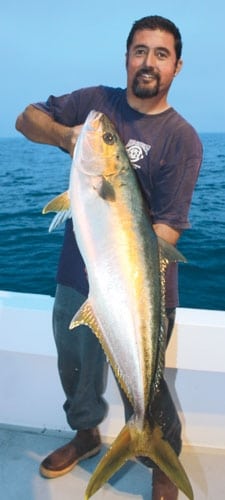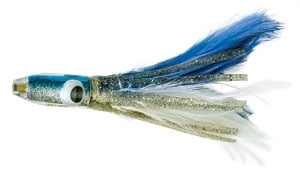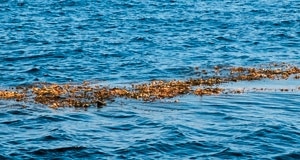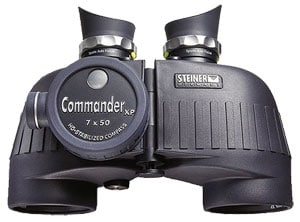
The fall months offer Southern California anglers some of the best offshore fishing of the year. The water is usually at its warmest, with surface temperatures in the low to mid-70s. The weather is often beautiful, with crisp mornings and warm, greasy-calm afternoons. And it’s not unusual for anglers to have legitimate shots at yellowfin tuna, dorado or yellowtail, or even all three on the same day. Occasionally, bigeye tuna approaching 100 pounds jump on trolled lures and add an extra bit of excitement.
It’s also not unusual for crowds at launch ramps and landings to be surprisingly low even though popular game fish can be prowling relatively close to the coast. For fishermen in the know, however, fall is time to hit the water and mix it up with hard-fighting offshore fish.
One of the most effective and popular ways for private boaters to target these fall visitors is to focus on offshore kelp paddies. These floating mats of kelp – which vary from the diameter of a trash-can lid to the size of a garage door – break loose from coastal and island kelp beds and drift with winds and currents. As they do, they often attract a movable feast. Small baitfish gather under and around the kelp stringers for shelter, and predatory game fish are drawn to these food stops like humans are to 7-Elevens in the desert.
Even with the absence of summer crowds, fish-laden paddies quickly become popular places, especially on weekends. If paddies are plentiful, try to find one of your own. If you’ve put in the time and feel it’s now or never, approach slowly from downwind and hail the other boat on the VHF to ask if you can take a drift. Showing courtesy – rather than just crashing the party – often elicits a positive response. Set your drift a good distance from the paddy so that both boats can fish effectively.

In this style of fishing, success or failure turns on a dime. One paddy, one jig strike or one porpoise school can make your day. Successful anglers make the most of each opportunity. Get chum and live baits in the water right away after a jig strike. Bring hooked fish to the boat as quickly as possible. Yellowtail, tuna and dorado can all appear in open water and will follow hooked fish to the boat.
Before you leave a productive paddy, drop a live bait underneath a 4-ounce torpedo sinker to fish that may be deep beneath the canopy. Or drop a heavy yo-yo iron down 100 feet and rip it toward the surface.
When I return to a paddy after a long drift, I troll a live bait on the way back and often pick up fish circling the kelp.
Rods: 7-foot, medium-action conventional rods rated for 15- to 40-pound-test. Try a Calstar 700XL or 700L or a Super Seeker 870 or 970.
Reels: High-speed star- or lever-drag conventional reel appropriate for 20- to 30-pound mono. Avet MX or JX, Shimano Torium 20 or Daiwa Saltist 30T are good choices.
Lines: 20-, 25- or 30-pound monofilament. Use a 3-foot fluorocarbon leader if fish are line shy.
Hooks: Live-bait hooks sized to match bait: No. 4 or No. 2 for anchovies, 2/0 to 3/0 for sardines and 5/0 for live mackerel.
Lures: For trolling, small tuna feathers, cedar plugs or lipped diving plugs rigged on stout 60-pound trolling outfits. For fishing paddies, heavy iron jigs like Tady 9 and Salas 6X Jr., as well as 5- or 6-inch swimbaits.
Paddy Pointers
Here are five tips to help anglers catch more of Southern California’s popular offshore species this fall:
1. Do Your Homework

Before you can successfully catch tuna, ‘tails and dorado around kelp paddies, you have to find them. And this can be a real challenge on the open ocean. Savvy anglers know that offshore banks and canyons cause currents and upwellings that can concentrate paddies. Well-known offshore banks like the 277, 43, 181, 182, 209 and 302 fathom spots are all fertile hunting grounds, as are the many high spots from Catalina Island to below the Mexican border. Check fishing websites, visit tackle stores and call buddies to find out all you can about where paddy hunting has been good.
2. Be the Early Bird
If your intelligence indicates you should be hunting a bank 40 miles from port, you want to leave early enough to be there with the sunrise. The first boat to visit a particular kelp paddy usually enjoys the best fishing. The more paddies you hit early in the day, the better. This is especially true on busy weekends. Leaving early also allows you to run past your target zone and begin your search heading back toward the coast. The first light creeping over the eastern horizon provides some of the best paddy-spotting conditions of the day.
3. Keep Your Eyes Open

Since fall fishing success usually revolves around spotting kelp paddies, everybody on board should be actively involved in the hunt. This means every set of eyes should be trained on the water. A high vantage point, such as a flybridge or tuna tower, can help you spot floating kelp from a much greater distance. A good pair of 7×50 marine binoculars is also indispensable. In addition to paddies, you should watch for working or sitting birds, jumping dolphin (which can accompany yellowfin tuna), fish boiling on baitfish, and other boats that have stopped.
4. Make the Right Approach
Most boaters approach way too close to paddies and mistakenly believe they must cast their baits right on the kelp to get bit. Instead, approach the paddy from upwind and set up so you drift past about 75 feet away. If the fish are there, they’ll come out for your live, fly-lined sardines, anchovies or mackerel. A few pieces of live or cut chum help, plus you’ll stand a better chance of keeping determined yellowtail from burrowing back into the weeds, something they’re very good at. If you keep a steady trickle of chum going, the fish will often stay with the boat for long drifts.
5. Slow Down and Troll
Some boaters think that by cruising at 20 knots they’ll cover more water and have a better chance of finding paddies and fish. This just increases the chance you’ll drive past productive kelps without ever seeing them. When you get in your prime hunting zone, settle in to a nice 6- to 7-knot speed and put some jigs out. Trolling feathers or lipped diving plugs, such as Rapalas and Yo-Zuris, will often pick up cruising fish while you’re hunting. If you’re lucky, this can turn into to an open-water bait bite. Sometimes getting a jig strike is the first indicator you’re getting close to a paddy, so take a look around you before going back on the hunt. Pulling a jig is also a great way to scout out small kelps to see if there are any fish home before investing any live bait: Troll past 10 yards away and see if you get slammed.









